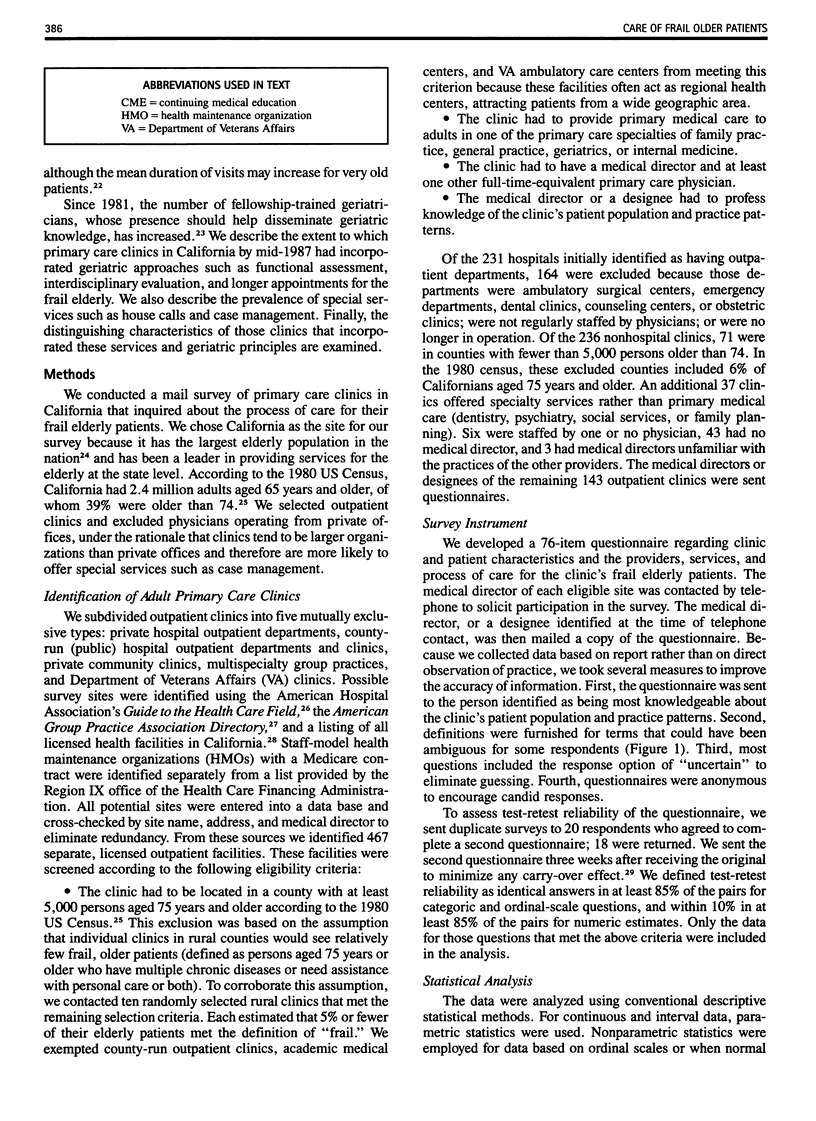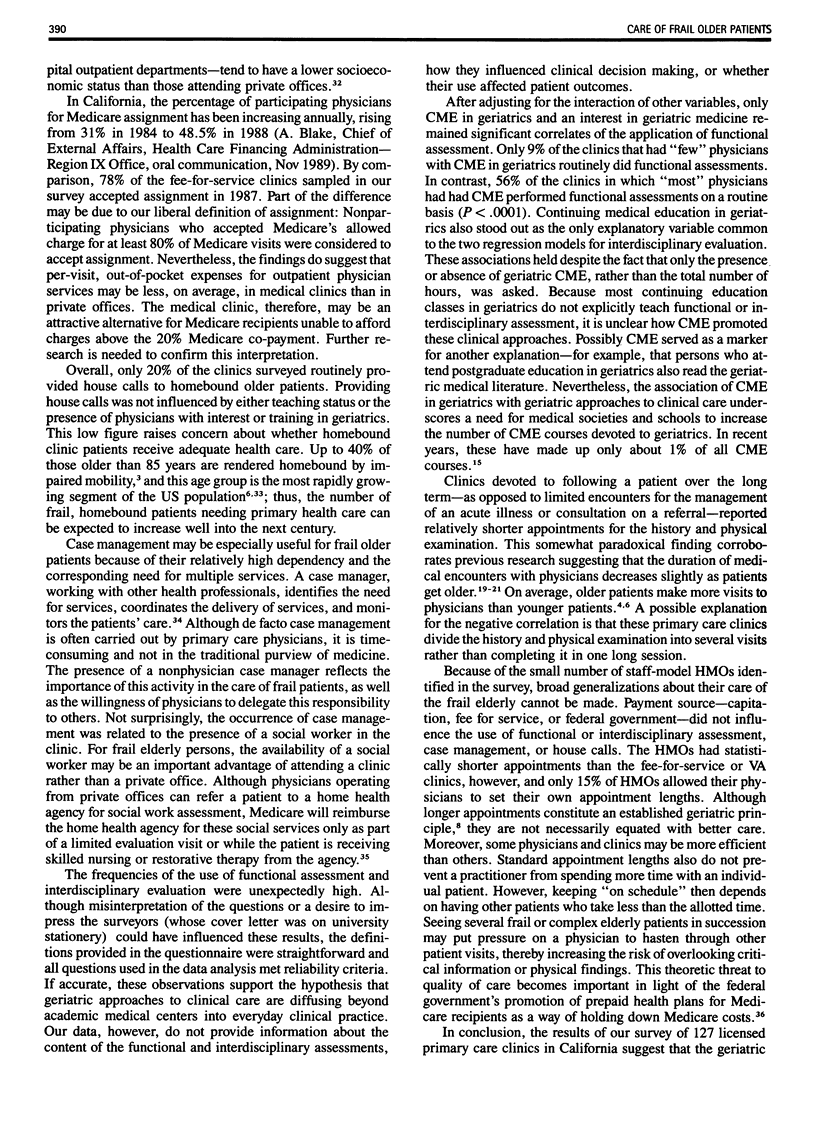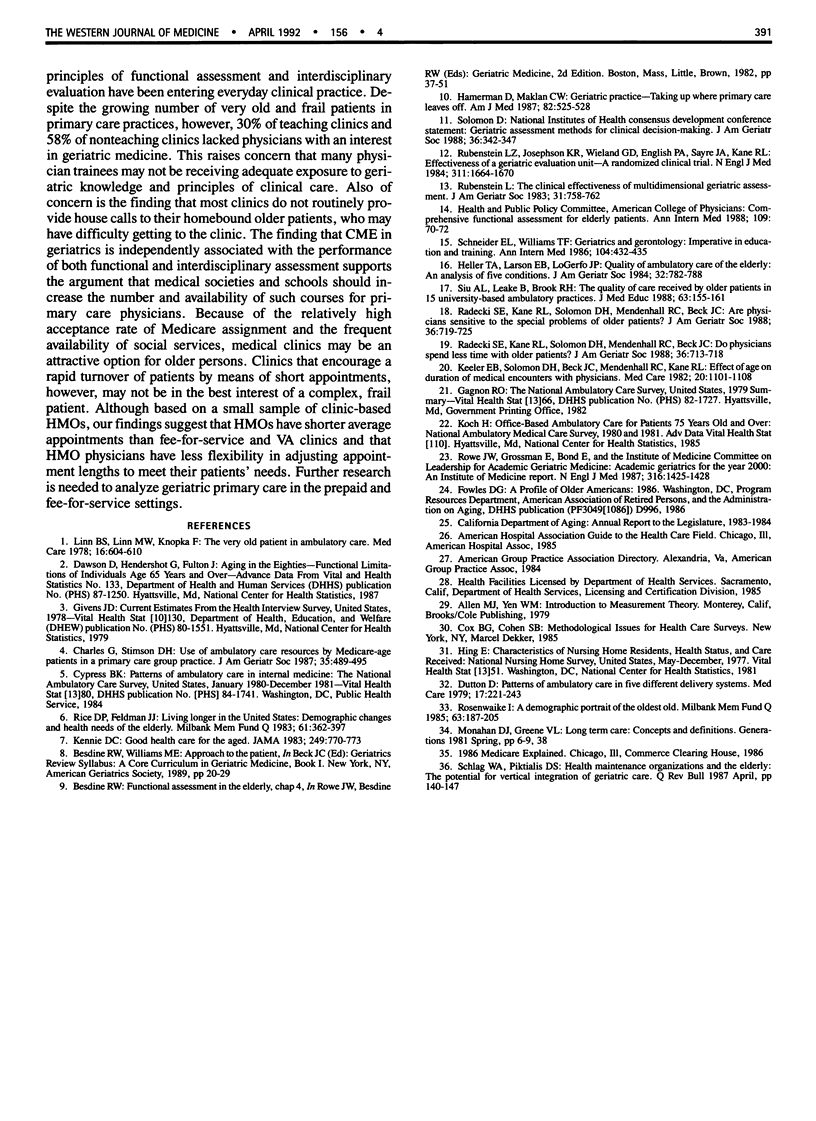Abstract
We surveyed medical directors of primary care clinics in California to learn how those clinics cared for their frail older patients. Of 143 questionnaires sent, 127 (89%) were returned. A median of 30% of all patient encounters were with persons aged 65 or older, and a median of 20% of older patients were considered frail. A total of 20% of the clinics routinely provided house calls to homebound elderly patients. Of clinics involved in training medical students of physicians (teaching clinics), 70% had at least one physician with an interest in geriatrics, compared with 42% of nonteaching clinics (P less than .005). For frail patients, 40% of the clinics routinely performed functional assessment, while 20% routinely did an interdisciplinary evaluation. Continuing education in geriatrics emerged as a significant independent correlate of both functional assessment and interdisciplinary evaluation. Among the 94 clinics with a standard appointment length for the history and physical examination, only 11 (12%) allotted more than 60 minutes for frail patients. The data suggest that certain geriatric approaches are being incorporated into clinic-based primary care in California but do not provide insight into their content or clinical effects.
Full text
PDF






Selected References
These references are in PubMed. This may not be the complete list of references from this article.
- Charles G., Stimson D. H. Use of ambulatory care resources by Medicare-age patients in a primary care group practice. J Am Geriatr Soc. 1987 Jun;35(6):489–495. doi: 10.1111/j.1532-5415.1987.tb01393.x. [DOI] [PubMed] [Google Scholar]
- Dutton D. B. Patterns of ambulatory health care in five different delivery systems. Med Care. 1979 Mar;17(3):221–243. doi: 10.1097/00005650-197903000-00001. [DOI] [PubMed] [Google Scholar]
- Hamerman D., Maklan C. W. Geriatric practice. Taking up where primary care leaves off. Am J Med. 1987 Mar;82(3):525–528. doi: 10.1016/0002-9343(87)90454-2. [DOI] [PubMed] [Google Scholar]
- Heller T. A., Larson E. B., LoGerfo J. P. Quality of ambulatory care of the elderly: an analysis of five conditions. J Am Geriatr Soc. 1984 Nov;32(11):782–788. doi: 10.1111/j.1532-5415.1984.tb06297.x. [DOI] [PubMed] [Google Scholar]
- Keeler E. B., Solomon D. H., Beck J. C., Mendenhall R. C., Kane R. L. Effect of patient age on duration of medical encounters with physicians. Med Care. 1982 Nov;20(11):1101–1108. doi: 10.1097/00005650-198211000-00005. [DOI] [PubMed] [Google Scholar]
- Kennie D. C. Good health care for the aged. JAMA. 1983 Feb 11;249(6):770–773. [PubMed] [Google Scholar]
- Linn B. S., Linn M. W., Knopka F. The very old patient in ambulatory care. Med Care. 1978 Jul;16(7):604–610. doi: 10.1097/00005650-197807000-00007. [DOI] [PubMed] [Google Scholar]
- National Institutes of Health Consensus Development Conference Statement: geriatric assessment methods for clinical decision-making. J Am Geriatr Soc. 1988 Apr;36(4):342–347. doi: 10.1111/j.1532-5415.1988.tb02362.x. [DOI] [PubMed] [Google Scholar]
- Radecki S. E., Kane R. L., Solomon D. H., Mendenhall R. C., Beck J. C. Are physicians sensitive to the special problems of older patients? J Am Geriatr Soc. 1988 Aug;36(8):719–725. doi: 10.1111/j.1532-5415.1988.tb07174.x. [DOI] [PubMed] [Google Scholar]
- Radecki S. E., Kane R. L., Solomon D. H., Mendenhall R. C., Beck J. C. Do physicians spend less time with older patients? J Am Geriatr Soc. 1988 Aug;36(8):713–718. doi: 10.1111/j.1532-5415.1988.tb07173.x. [DOI] [PubMed] [Google Scholar]
- Rice D. P., Feldman J. J. Living longer in the United States: demographic changes and health needs of the elderly. Milbank Mem Fund Q Health Soc. 1983 Summer;61(3):362–396. [PubMed] [Google Scholar]
- Rosenwaike I. A demographic portrait of the oldest old. Milbank Mem Fund Q Health Soc. 1985 Spring;63(2):187–205. [PubMed] [Google Scholar]
- Rowe J. W., Grossman E., Bond E. Academic geriatrics for the year 2000. An Institute of Medicine report. N Engl J Med. 1987 May 28;316(22):1425–1428. doi: 10.1056/NEJM198705283162229. [DOI] [PubMed] [Google Scholar]
- Rubenstein L. Z., Josephson K. R., Wieland G. D., English P. A., Sayre J. A., Kane R. L. Effectiveness of a geriatric evaluation unit. A randomized clinical trial. N Engl J Med. 1984 Dec 27;311(26):1664–1670. doi: 10.1056/NEJM198412273112604. [DOI] [PubMed] [Google Scholar]
- Rubenstein L. The clinical effectiveness of multidimensional geriatric assessment. J Am Geriatr Soc. 1983 Dec;31(12):758–762. doi: 10.1111/j.1532-5415.1983.tb03395.x. [DOI] [PubMed] [Google Scholar]
- Schlag W. A., Piktialis D. S. Health maintenance organizations and the elderly: the potential for vertical integration of geriatric care. QRB Qual Rev Bull. 1987 Apr;13(4):140–147. doi: 10.1016/s0097-5990(16)30122-1. [DOI] [PubMed] [Google Scholar]
- Schneider E. L., Williams T. F. Geriatrics and gerontology: imperatives in education and training. Ann Intern Med. 1986 Mar;104(3):432–435. doi: 10.7326/0003-4819-104-3-432. [DOI] [PubMed] [Google Scholar]
- Siu A. L., Leake B., Brook R. H. The quality of care received by older patients in 15 university-based ambulatory practices. J Med Educ. 1988 Mar;63(3):155–161. doi: 10.1097/00001888-198803000-00001. [DOI] [PubMed] [Google Scholar]


